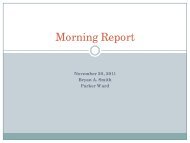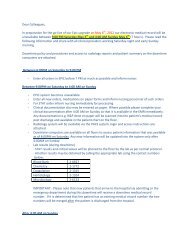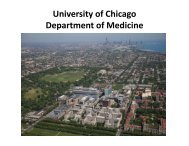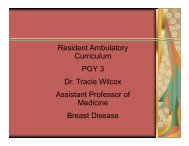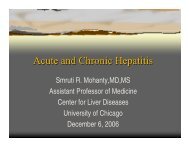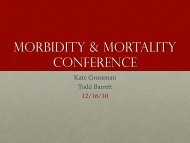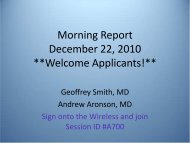Preoperative Evaluation for Non-Cardiac Surgery
Preoperative Evaluation for Non-Cardiac Surgery
Preoperative Evaluation for Non-Cardiac Surgery
Create successful ePaper yourself
Turn your PDF publications into a flip-book with our unique Google optimized e-Paper software.
<strong>Preoperative</strong> <strong>Evaluation</strong><br />
<strong>for</strong><br />
<strong>Non</strong>-<strong>Cardiac</strong> <strong>Non</strong> <strong>Cardiac</strong> <strong>Surgery</strong><br />
Resident Core Curriculum<br />
Lecture Series<br />
Cardiology Rotation
Goals of the <strong>Preoperative</strong><br />
CV evaluation<br />
Focus on preoperative risk stratification<br />
Need <strong>for</strong> further testing<br />
Optimizing medical management<br />
There is no “cardiac cardiac clearance”!<br />
clearance
New<br />
Guidelines<br />
Fleicher, et al.<br />
JACC 2009;54:e13-118
History<br />
General <strong>Evaluation</strong><br />
– Any history of CAD, CV risk factors<br />
– Assess <strong>for</strong> clinic risk factors* factors<br />
CAD<br />
CHF<br />
DM<br />
CRI<br />
CVA<br />
– Any prior testing on the heart<br />
– Assessment of functional ability<br />
PE
<strong>Cardiac</strong> <strong>Evaluation</strong> and Care Algorithm <strong>for</strong><br />
<strong>Non</strong>cardiac <strong>Surgery</strong> (1)<br />
Step 1<br />
Step 3<br />
Need <strong>for</strong> emergency<br />
<strong>Non</strong> cardiac surgery?<br />
No<br />
Yes<br />
(Class I, LOE C)<br />
Operating room<br />
Perioperative surveillance<br />
and postoperative risk<br />
stratification and risk factor<br />
management<br />
Fleicher, et al. JACC 2009;54:e13-118
<strong>Cardiac</strong> <strong>Evaluation</strong> and Care Algorithm <strong>for</strong><br />
<strong>Non</strong>cardiac <strong>Surgery</strong> (1)<br />
Step 1<br />
Step 2<br />
Step 3<br />
Need <strong>for</strong> emergency<br />
<strong>Non</strong> cardiac surgery?<br />
No<br />
Active cardiac<br />
conditions*<br />
Yes<br />
(Class I, LOE C)<br />
Yes<br />
(Class I, LOE B)<br />
Operating room<br />
Evaluate and treat per<br />
ACC/AHA guidelines<br />
Perioperative surveillance<br />
and postoperative risk<br />
stratification and risk factor<br />
management<br />
Consider<br />
operating room<br />
Fleicher, et al. JACC 2009;54:e13-118
Active <strong>Cardiac</strong> Conditions <strong>for</strong> Which the Patient<br />
Should Undergo <strong>Evaluation</strong> and Treatment Be<strong>for</strong>e<br />
<strong>Non</strong>cardiac <strong>Surgery</strong> (Class 1, LOE: B)<br />
Condition Examples<br />
Unstable coronary syndromes <br />
Decompensated HF (NYHA<br />
functional class IV; worsening<br />
or new-onset new onset HF)<br />
Significant arrhythmias <br />
<br />
<br />
<br />
<br />
<br />
Unstable or severe angina* (CCS class III or IV)† IV)<br />
Recent MI‡ MI<br />
High-grade High grade atrioventricular block<br />
Mobitz II atrioventricular block<br />
Third-degree Third degree atrioventricular heart block<br />
Symptomatic ventricular arrhythmias<br />
Supraventricular arrhythmias (including atrial fibrillation) with with<br />
uncontrolled ventricular rate (HR > 100 bpm at rest)<br />
Symptomatic bradycardia<br />
Newly recognized ventricular tachycardia<br />
Severe valvular disease Severe aortic stenosis (mean pressure gradient > 40 mm Hg, aortic aortic<br />
valve area < 1.0 cm 2 , or symptomatic)<br />
Symptomatic mitral stenosis (progressive dyspnea on exertion,<br />
exertional presyncope, or HF) or MVA
<strong>Cardiac</strong> <strong>Evaluation</strong> and Care Algorithm <strong>for</strong><br />
<strong>Non</strong>cardiac <strong>Surgery</strong> (1)<br />
Step 1<br />
Step 2<br />
Step 3<br />
Need <strong>for</strong> emergency<br />
<strong>Non</strong> cardiac surgery?<br />
No<br />
Active cardiac<br />
conditions*<br />
No<br />
Low risk surgery<br />
Yes<br />
(Class I, LOE C)<br />
Yes<br />
(Class I, LOE B)<br />
Yes<br />
(Class I, LOE B)<br />
Operating room<br />
Evaluate and treat per<br />
ACC/AHA guidelines<br />
Proceed with<br />
planned surgery<br />
Perioperative surveillance<br />
and postoperative risk<br />
stratification and risk factor<br />
management<br />
Consider<br />
operating room<br />
Fleicher, et al. JACC 2009;54:e13-118
<strong>Cardiac</strong> Risk Stratification <strong>for</strong><br />
<strong>Non</strong>cardiac Surgical Procedures<br />
High<br />
(cardiac risk >5%)<br />
Intermediate<br />
(cardiac risk
<strong>Cardiac</strong> <strong>Evaluation</strong> and Care Algorithm <strong>for</strong><br />
<strong>Non</strong>cardiac <strong>Surgery</strong> (1)<br />
Step 1<br />
Step 2<br />
Step 3<br />
Step 4<br />
Need <strong>for</strong> emergency<br />
<strong>Non</strong> cardiac surgery?<br />
No<br />
Active cardiac<br />
conditions*<br />
No<br />
Low risk surgery<br />
No<br />
Functional capacity greater than or<br />
equal to 4 METs without symptoms.<br />
‡<br />
Yes<br />
(Class I, LOE C)<br />
Yes<br />
(Class I, LOE B)<br />
Yes<br />
(Class I, LOE B)<br />
Operating room<br />
Evaluate and treat per<br />
ACC/AHA guidelines<br />
Proceed with<br />
planned surgery<br />
Yes<br />
(Class IIa, LOE B)<br />
Perioperative surveillance<br />
and postoperative risk<br />
stratification and risk factor<br />
management<br />
Consider<br />
operating room<br />
Proceed with<br />
planned surgery<br />
Fleicher, et al. JACC 2009;54:e13-118
Estimated Energy Requirements <strong>for</strong><br />
Various Activities<br />
Can You… You<br />
Can You… You<br />
1 Met Take care of yourself? 4 Mets Climb a flight of stairs or walk<br />
up a hill?<br />
Eat, dress, or use the toilet? Walk on level ground at 4 mph<br />
(6.4 kph)?<br />
Walk indoors around the<br />
house?<br />
Walk a block or 2 on level<br />
ground at 2 to 3 mph (3.2 to<br />
4.8 kph)?<br />
4 Mets Do light work around the<br />
house like dusting or<br />
washing dishes?<br />
> 10<br />
Mets<br />
Do heavy work around the<br />
house like scrubbing floors or<br />
lifting or moving heavy<br />
furniture?<br />
Participate in moderate<br />
recreational activities like golf,<br />
bowling, dancing, doubles<br />
tennis, or throwing a baseball<br />
or football?<br />
Participate in strenuous sports<br />
like swimming, singles tennis,<br />
football, basketball, or skiing?
<strong>Cardiac</strong> <strong>Evaluation</strong> and Care Algorithm <strong>for</strong><br />
<strong>Non</strong>cardiac <strong>Surgery</strong> (2)<br />
Vascular <strong>Surgery</strong><br />
Class IIa,<br />
LOE B<br />
Step 5<br />
Consider testing if it will<br />
change management <br />
No or unknown<br />
3 or more clinical<br />
risk factors?<br />
Intermediate<br />
risk surgery<br />
Vascular <strong>Surgery</strong><br />
1-2 clinical<br />
risk factors?<br />
Intermediate risk<br />
surgery<br />
Proceed with planned surgery with HR control (Class IIa, LOE B)<br />
or consider noninvasive testing (Class IIb LOE B) if it will change<br />
with management<br />
No clinical<br />
risk factors<br />
Class I<br />
LOE B<br />
Proceed with<br />
planned surgery<br />
*Clinical RF: CAD, CHF, DM, PAD, CRI, Cerebrovascular disease Fleicher, et al. JACC 2009;54:e13-118
Stress test: to do or not to do?<br />
Consider if:<br />
– Unable to assess function status<br />
– >1 clinical risk factor and it will change<br />
management<br />
Alternative is: proceed with optimal HR<br />
control
Prognostic Gradient of Ischemic Responses During<br />
an ECG-Monitored ECG Monitored Exercise Test in Patients With<br />
Suspected or Proven CAD<br />
High Risk Ischemic Response<br />
Ischemia induced by low-level low level exercise* (less than 4<br />
METs or heart rate < 100 bpm or < 70% of age- age<br />
predicted heart rate)<br />
manifested by 1 or more of the following:<br />
• Horizontal or downsloping ST depression > 0.1 mV<br />
• ST-segment ST segment elevation > 0.1 mV in noninfarct lead<br />
• Five or more abnormal leads<br />
• Persistent ischemic response >3 minutes after<br />
exertion<br />
• Typical angina<br />
• Exercise-induced Exercise induced decrease in systolic BP by 10 mm<br />
Hg
Prognostic Gradient of Ischemic Responses During<br />
an ECG-Monitored ECG Monitored Exercise Test in Patients With<br />
Suspected or Proven CAD<br />
Intermediate:<br />
Ischemia induced by moderate-level moderate level exercise (4 to 6 METs or HR 100 to<br />
130 bpm (70% to 85% of age-predicted age predicted heart rate)) manifested by > 1 of<br />
the following:<br />
• Horizontal or downsloping ST depression > 0.1 mV<br />
• Persistent ischemic response greater than 1 to 3 minutes after exertion exertion<br />
• 3- 4 abnormal leads<br />
Low<br />
No ischemia or ischemia induced at high-level high level exercise (> 7 METs or HR<br />
>130 bpm (> 85% of age-predicted age predicted heart rate)) manifested by:<br />
• Horizontal or downsloping ST depression > 0.1 mV<br />
• 1- 2 abnormal leads<br />
Inadequate test<br />
Inability to reach adequate target workload or heart rate response response<br />
<strong>for</strong> age<br />
without an ischemic response. For patients undergoing noncardiac surgery,<br />
the inability to exercise to at least the intermediate-risk intermediate risk level without<br />
ischemia should be considered an inadequate test.
B-Blockers Blockers<br />
Continue in patients who are already on it<br />
<strong>for</strong> angina, CHF or HTN (class I)<br />
Give to (class IIa) IIa<br />
– Vascular surgery pts with ischemia on preop<br />
testing (CAD)<br />
– Vascular surgery pts with >1 clinical risk<br />
factor<br />
– Intermediate surgery pts with >1 RF<br />
undergoing intermediate risk surgery<br />
Titrate to HR and BP
Recommendations <strong>for</strong> Perioperative<br />
Beta-Blocker Beta Blocker Therapy<br />
<strong>Surgery</strong> Low <strong>Cardiac</strong><br />
Risk<br />
Vascular Class llb, Level of<br />
Evidence: B<br />
Intermediate<br />
risk<br />
CAD or High<br />
Risk (1 or more<br />
clinical risk<br />
factors)<br />
Class lla, Level of<br />
Evidence: B<br />
… Class lla, Level of<br />
Evidence: B<br />
Patients<br />
Currently Taking<br />
Beta Blockers<br />
Class 1, Level of<br />
Evidence: C<br />
Class 1, Level of<br />
Evidence: C<br />
Low risk … … Class 1, Level of<br />
Evidence: C<br />
Fleicher, et al. JACC 2009;54:e13-118
Revascularization prior to surgery<br />
Class I indications<br />
Stable angina with L. Main dz<br />
Stable angina and 3v. Dz<br />
Stable angina and 2v. Dz with prox LAD and either low<br />
EF or ischemia on stress<br />
High risk USA or NSTEMI<br />
Acute STEMI<br />
Class IIa Indications<br />
Symptomatic, appropriate <strong>for</strong> PCI, elective surgery<br />
NOT recommended<br />
As prophylaxis in patient with stable CAD prior to<br />
elective surgery
Proposed Treatment <strong>for</strong> Patients Requiring PCI<br />
Who Need Subsequent <strong>Surgery</strong><br />
Timing of surgery<br />
Acute MI, High risk ACS, or<br />
High risk cardiac anatomy<br />
Bleeding risk of surgery<br />
14-29 days 30-365 days >365 days<br />
Balloon<br />
Angioplasty<br />
Not low<br />
Bare Metal<br />
Stent<br />
low<br />
Drug eluting<br />
stent<br />
Stent & continue dual<br />
antiplatelet therapy<br />
Fleicher, et al. JACC 2009;54:e13-118
Proposed Approach to the Management of Patients<br />
with Previous PCI Who Require <strong>Non</strong>cardiac<br />
<strong>Surgery</strong><br />
Time since PCI<br />
14 days<br />
Proceed to the<br />
operation room<br />
with aspirin<br />
Previous PCI<br />
Bare-metal<br />
stent<br />
>30- 45 days
Anticoagulation in CAD pts<br />
Continue ASA if at all possible<br />
Plavix<br />
– Discontinue 4-6 4 6 weeks after POBA or BMS<br />
– For DES, Discontinue a minimum of:<br />
<br />
<br />
Ideally continued <strong>for</strong> 1 year<br />
Discontinue <strong>for</strong> the shortest time duration possible<br />
perioperatively
<strong>Non</strong>-<strong>Cardiac</strong> <strong>Non</strong> <strong>Cardiac</strong> <strong>Surgery</strong><br />
<strong>Cardiac</strong> Stressors<br />
Many potential cardiovascular stressors<br />
– Pre-operative<br />
Pre operative<br />
potential discontinuation cardiac, anti-hypertensive anti hypertensive medicines<br />
limited activity level<br />
– Intra-operative<br />
Intra operative<br />
Anesthesia (HR and BP variability) fluid shifts / blood loss,<br />
cathecholamine surges, arrhythmias, pain<br />
high risk techniques (aortic cross clamping, etc)<br />
– Post-operative<br />
Post operative<br />
pain, pulmonary complications, hypoxia , infection, fluid and<br />
electrolyte imbalances<br />
high norepinephrine levels<br />
hypercoaguability (peaks day 2-5) 2 5)
Surveillance Postoperatively <strong>for</strong><br />
<br />
Guidelines<br />
Myocardial Infarction<br />
Low Low / Intermediate risk patients:<br />
<br />
<br />
<strong>Cardiac</strong> enzymes not routinely recommended<br />
because incidence of peri-op peri op MI is low<br />
only if ECG, clinical course suggest ischemia<br />
High High risk patients:<br />
ECG ECG suggested immediately post-op post op and on POD #<br />
1 & 2.<br />
cardiac cardiac enzymes reasonable
Case<br />
45 y/o male with history of DM, HTN,<br />
Chol, Chol,<br />
CRI and CVA presents <strong>for</strong> lung<br />
resection surgery <strong>for</strong> lung cancer.<br />
Asymptomatic (no CP or SOB)<br />
He doesn’t doesn t really leave the house but can<br />
do normal daily activities/take care of<br />
himself. His wife does most of the<br />
cleaning. Can walk about 1 block.<br />
Takes ASA, Lisinopril, Lisinopril,<br />
Zocor, Zocor,<br />
Met<strong>for</strong>min
<strong>Cardiac</strong> <strong>Evaluation</strong> and Care Algorithm <strong>for</strong><br />
<strong>Non</strong>cardiac <strong>Surgery</strong> (1)<br />
Step 1<br />
Step 2<br />
Step 3<br />
Step 4<br />
Need <strong>for</strong> emergency<br />
<strong>Non</strong> cardiac surgery?<br />
No<br />
Active cardiac<br />
conditions*<br />
No<br />
Low risk surgery<br />
No<br />
Functional capacity greater than or<br />
equal to 4 METs without symptoms.<br />
‡<br />
Yes<br />
(Class I, LOE C)<br />
Yes<br />
(Class I, LOE B)<br />
Yes<br />
(Class I, LOE B)<br />
Operating room<br />
Evaluate and treat per<br />
ACC/AHA guidelines<br />
Proceed with<br />
planned surgery<br />
Yes<br />
(Class IIa, LOE B)<br />
Perioperative surveillance<br />
and postoperative risk<br />
stratification and risk factor<br />
management<br />
Consider<br />
operating room<br />
Proceed with<br />
planned surgery
<strong>Cardiac</strong> <strong>Evaluation</strong> and Care Algorithm <strong>for</strong><br />
<strong>Non</strong>cardiac <strong>Surgery</strong> (2)<br />
Vascular <strong>Surgery</strong><br />
Class IIa,<br />
LOE B<br />
Step 5<br />
Consider testing if it will<br />
change management <br />
No or unknown<br />
3 or more clinical<br />
risk factors?<br />
Intermediate<br />
risk surgery<br />
Vascular <strong>Surgery</strong><br />
1-2 clinical<br />
risk factors?<br />
Intermediate risk<br />
surgery<br />
Proceed with planned surgery with HR control (Class IIa, LOE B)<br />
or consider noninvasive testing (Class IIb LOE B) if it will change<br />
with management<br />
No clinical<br />
risk factors<br />
Class I<br />
LOE B<br />
Proceed with<br />
planned surgery
Decision tree<br />
<strong>Non</strong>-emergent <strong>Non</strong> emergent surgery<br />
No active cardiac conditions<br />
Intermediate risk surgery<br />
Poor/unable to assess functional status<br />
3 clinical risk factors<br />
Proceed with planned surgery with HR control or<br />
consider non-invasive non invasive testing if it will change<br />
management<br />
– Regedenoson Nuclear Stress test showed borderline-mild<br />
borderline mild<br />
multivessel ischemia, SSS=7. No focal abnormalities, EF 50%
Plan<br />
Stress shows only mild ischemia<br />
NO indication <strong>for</strong> prophylactic<br />
revascularization in this patient with stable<br />
CAD undergoing elective (semi-urgent)<br />
(semi urgent)<br />
surgery<br />
B-blocker blocker added <strong>for</strong> medical optimization<br />
Patient did well post-operatively<br />
post operatively
Key Points<br />
Preop Risk assessment<br />
– Functional status is key<br />
– Risk of surgery<br />
– Clinical risk factors<br />
Stress test if it will change management<br />
B-blockers blockers<br />
Postop surveillance



